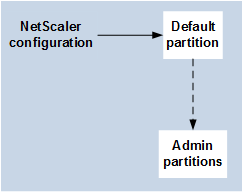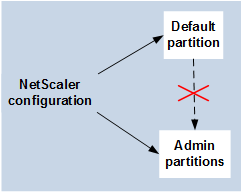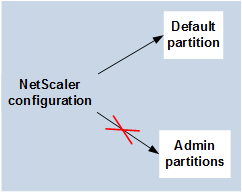-
Getting Started with NetScaler
-
Solutions for Telecom Service Providers
-
Load Balance Control-Plane Traffic that is based on Diameter, SIP, and SMPP Protocols
-
Provide Subscriber Load Distribution Using GSLB Across Core-Networks of a Telecom Service Provider
-
Authentication, authorization, and auditing application traffic
-
Basic components of authentication, authorization, and auditing configuration
-
Web Application Firewall protection for VPN virtual servers and authentication virtual servers
-
On-premises NetScaler Gateway as an identity provider to Citrix Cloud™
-
Authentication, authorization, and auditing configuration for commonly used protocols
-
Troubleshoot authentication and authorization related issues
-
-
-
-
-
-
Persistence and persistent connections
-
Advanced load balancing settings
-
Gradually stepping up the load on a new service with virtual server–level slow start
-
Protect applications on protected servers against traffic surges
-
Retrieve location details from user IP address using geolocation database
-
Use source IP address of the client when connecting to the server
-
Use client source IP address for backend communication in a v4-v6 load balancing configuration
-
Set a limit on number of requests per connection to the server
-
Configure automatic state transition based on percentage health of bound services
-
-
Use case 2: Configure rule based persistence based on a name-value pair in a TCP byte stream
-
Use case 3: Configure load balancing in direct server return mode
-
Use case 6: Configure load balancing in DSR mode for IPv6 networks by using the TOS field
-
Use case 7: Configure load balancing in DSR mode by using IP Over IP
-
Use case 10: Load balancing of intrusion detection system servers
-
Use case 11: Isolating network traffic using listen policies
-
Use case 12: Configure Citrix Virtual Desktops for load balancing
-
Use case 13: Configure Citrix Virtual Apps and Desktops for load balancing
-
Use case 14: ShareFile wizard for load balancing Citrix ShareFile
-
Use case 15: Configure layer 4 load balancing on the NetScaler appliance
-
-
-
-
Authentication and authorization for System Users
-
-
Configuring a CloudBridge Connector Tunnel between two Datacenters
-
Configuring CloudBridge Connector between Datacenter and AWS Cloud
-
Configuring a CloudBridge Connector Tunnel Between a Datacenter and Azure Cloud
-
Configuring CloudBridge Connector Tunnel between Datacenter and SoftLayer Enterprise Cloud
-
Configuring a CloudBridge Connector Tunnel Between a NetScaler Appliance and Cisco IOS Device
-
CloudBridge Connector Tunnel Diagnostics and Troubleshooting
This content has been machine translated dynamically.
Dieser Inhalt ist eine maschinelle Übersetzung, die dynamisch erstellt wurde. (Haftungsausschluss)
Cet article a été traduit automatiquement de manière dynamique. (Clause de non responsabilité)
Este artículo lo ha traducido una máquina de forma dinámica. (Aviso legal)
此内容已经过机器动态翻译。 放弃
このコンテンツは動的に機械翻訳されています。免責事項
이 콘텐츠는 동적으로 기계 번역되었습니다. 책임 부인
Este texto foi traduzido automaticamente. (Aviso legal)
Questo contenuto è stato tradotto dinamicamente con traduzione automatica.(Esclusione di responsabilità))
This article has been machine translated.
Dieser Artikel wurde maschinell übersetzt. (Haftungsausschluss)
Ce article a été traduit automatiquement. (Clause de non responsabilité)
Este artículo ha sido traducido automáticamente. (Aviso legal)
この記事は機械翻訳されています.免責事項
이 기사는 기계 번역되었습니다.책임 부인
Este artigo foi traduzido automaticamente.(Aviso legal)
这篇文章已经过机器翻译.放弃
Questo articolo è stato tradotto automaticamente.(Esclusione di responsabilità))
Translation failed!
NetScaler configurations support in admin partition
NetScaler configurations can be categorized into the following three types of configurations. It depends on the Citrix configuration and the partition in which the configuration is performed.
Note
- Admin partitions cannot be set up on a NetScaler cluster. It means that a NetScaler cluster cannot be partitioned.
- Admin partitions are not supported on a NetScaler 14000 FIPS appliance.
- Case 3 lists the NetScaler features that are not supported in admin partitions.
- Load balancing templates are not supported in admin partitions.
Case 1 (global configurations)
Configurations that can be performed ONLY in the default partition and which are available or impact all the admin partitions.

- Updates to built-in entities for monitors, TCP profiles, HTTP profiles, and so on.
- Updates to global parameters for syslog, NSLOG, weblog, content switching, IPSEC, SIP, DHCP, Surge protection, TCP buffering, and system collection.
- High availability (HA) configurations
- Interface and VLAN changes
- User configurations
Case 2 (partition-specific configurations)
Configurations that can be performed independently in default and admin partitions. These configurations are applicable only to the partition in which they are performed.

- Getting traffic level statistics for a partition.
- Partition admin can update IP bindings for VLAN which is bound to that partition. But cannot update the interface bindings.
- Clearing NetScaler configurations.
- Feature-specific parameters for the following features: AppFlow®, AppQoE, HTTP compression, DNS, TCP, HTTP, encryption, responder, rewrite, and SSL.
- Feature-specific configurations such as virtual servers, services, monitors.
Case 3
Configurations that cannot be performed on admin partitions. These features can be configured in the default partition, but there is no impact on admin partitions.

Note:
Configurations that are supported on admin partitions for a particular release are marked as Yes.
| Feature Component | NetScaler Feature | NetScaler 12.1 | NetScaler 13.0 | NetScaler 13.1 | NetScaler 14.1 |
|---|---|---|---|---|---|
| Networking | Traffic Domain | No | No | No | No |
| Policy | Extensibility | Yes | Yes | Yes | Yes |
| Load Balancing | DBS Autoscale | Yes | Yes | Yes | Yes |
| Load Balancing | DNSSEC | Yes | Yes | Yes | Yes |
| Load Balancing | Diameter | Yes | Yes | Yes | Yes |
| Load Balancing | RTSP | No | No | No | No |
| Load Balancing | Sure Connect | Deprecated | Deprecated | Removed | Removed |
| Load Balancing | Autoscale Service Group | Yes | Yes | Yes | Yes |
| Manageability | RBA External Authentication | Yes | Yes | Yes | Yes |
| Manageability | RISE Cisco | No | Yes | Yes | Yes |
| Manageability | AppExpert | Yes | Yes | Yes | Yes |
| Manageability | HDX Insight | No | No | No | No |
| Manageability | Insight | No | No | No | No |
| VPN | Citrix CloudBridge Connector | No | No | No | No |
| VPN | NetScaler Gateway or SSL VPN | No | No | No | No |
| VPN | SSL VPN ICA Proxy | No | No | No | No |
| VPN | Web Interface on NetScaler | No | No | No | No |
| SSL | SSL Profile | Yes | Yes | Yes | Yes |
| SSL | SSL-FIPS | No | No | No | No |
| SSL | External-HSM | No | No | No | No |
| Infra | Cache Redirection | No | No | No | No |
| Infra | Integrated Caching | Yes | Yes | Yes | Yes |
| Network | VXLAN | Yes | Yes | Yes | Yes |
| Network | Graceful Shutdown | Yes | Yes | Yes | Yes |
| Network | LSN | No | No | No | No |
| Network | IPv6 Ready Logo | Yes | Yes | Yes | Yes |
| Network | vPath | Yes | Yes | Yes | Yes |
| Load Balancing | Datastream | Yes | Yes | Yes | Yes |
| Logging | Web logging | Yes | Yes | Yes | Yes |
| Network | L2 Param/L3 Param | Yes | Yes | Yes | Yes |
| Network | GRE Tunnel | Yes | Yes | Yes | Yes |
| Loading Balancing | Scriptable Monitoring | Yes | Yes | Yes | Yes |
| Load Balancing | GSLB | Yes | Yes | Yes | Yes |
| Infra | Connection Mirroring | Yes | Yes | Yes | Yes |
| Infra | FEO | Yes | Yes | Yes | Yes |
| Infra | Ns trace | Yes | Yes | Yes | Yes |
| Load Balancing | Priority Queuing | Deprecated | Deprecated | Removed | Removed |
| Network | HDOSP | Deprecated | Deprecated | Removed | Removed |
| Network | Net profile | Yes | Yes | Yes | Yes |
| Network | Networking (Restricted Feature) | Yes | Yes | Yes | Yes |
| Network | VRRP (Restricted Feature) | Yes | Yes | Yes | Yes |
| Logging | Audit Logging (SYSLOG-TCP, LB of syslog servers, SNIP support, and FQDN support for syslog) | Yes | Yes | Yes | Yes |
| VPN | NetScaler Gateway | No | No | No | No |
| VPN | AAA-TM | Yes | Yes | Yes | Yes |
| AppFlow | AppFlow | Yes (IPFIX only) | Yes | Yes | Yes |
| AppFw | Application Firewall | No | No | No | No |
| URL transformation | URL transformation | No | No | No | No |
| Load Balancing | TCP Buffering | No | No | No | No |
| Policies | OCSP Responder | Yes | Yes | Yes | Yes |
| Audit Log | SYSLOG-TCP | Yes | Yes | Yes | Yes |
| Optimization | Front-end-optimization | Yes | Yes | Yes | Yes |
| AppQoE | AppQoE | Yes | Yes | Yes | Yes |
The preceding table lists some of the features as Restricted Features in the admin partition setup. The following section provides the reason why some of the features are mentioned as Restricted Features.
-
VRRP. The VRRP is Restricted Feature in the admin partition because of the following:
-
VRID addition or deletion can be done only from the default partition context. However, once a VRID is created, it can be used within non-default partitions.
-
VRRP functionality is supported only over the dedicated VLANs.
-
VRRP functionality is not supported on shared VLANs, used by the admin partition. It is blocked internally. No error message is shown during configuration. The protocol is blocked on a shared VLAN (tagged or untagged) bound to a default or any administrative partition.
-
Important
To support active-active deployment using VRRP, main and backup VIP must use the same VRID. Different VRIDs cannot be used.
- Networking. Some of the networking configurations (L2 Param and L3 Param) are not supported or valid in the partition context. If you come across any such configurations, the following error message is displayed. “ERROR: This configuration option is not supported on the non-default partition.”
Share
Share
This Preview product documentation is Cloud Software Group Confidential.
You agree to hold this documentation confidential pursuant to the terms of your Cloud Software Group Beta/Tech Preview Agreement.
The development, release and timing of any features or functionality described in the Preview documentation remains at our sole discretion and are subject to change without notice or consultation.
The documentation is for informational purposes only and is not a commitment, promise or legal obligation to deliver any material, code or functionality and should not be relied upon in making Cloud Software Group product purchase decisions.
If you do not agree, select I DO NOT AGREE to exit.